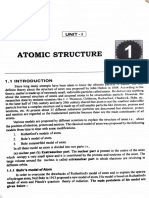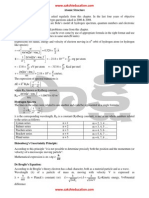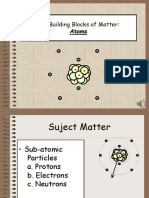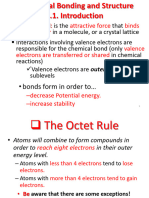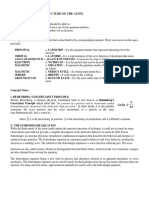GOIITJEE Atomic Structure Summary
➢
Specific charge = S.C = 9.5107 C / Kg
11
e (C.R)
➢ Properties of charge
ii) q = ne ( charge is quantized )
iii) iv)
where, = 9109 ( S.I), = 1 ( C.G.S)
If a charged particle q is placed on a surface of potential V then the potential energy of the charge is
given by ; P.E = q ×V
Kinetic energy gained by a particle of charge q , when potential of V volt is applied over it from rest
is; K.E = q × V
➢ energy units
1 eV = 1.6×10 – 19 J = 96 kJ mole – 1
➢ Statistics obtained from Rutherford’s model
i) Ratom = 10 – 8 cm iii) Ratom = 105× Rnucleus
ii) Rnucleus = 10 – 13 cm iv) Vatom = 1015 × Vnucleus
v) R = R0(A)1/3; R = radius of nucleus, A = mass no.
R0 = constant = 4 10−13 cm
vi) N 1 where N is the number of particles scattered at angle of θ
➢ Iso –series
i) isotope : same Z, diff A, diff A-z ii) isotone : diff z, diff A, same A-z iii) Isobar : diff z, same A, diff A-z
same isotopic no. i.e same (n – p) value or same (A – 2z) value
GOIITJEE - SALT LAKE 9874195675 | Deshapriyo Park 7044094543 | goiitjee@gmail.com | www.iitopper.com Page 1
� GOIITJEE Atomic Structure Summary
➢ Relation between parameters of electromagnetic wave
−
i)
iii) T = 1
➢ Electromagnetic spectrum
visible region lies in the range of 3800 – 7600 Å
➢ Planck’s Quantum Theory
12400
p
iii) E = nEp
broken atoms is ; K.E = (Ep – x) kJ-mol – 1
➢ Photo Electric Effect
[JEE]
0 0
e p 0
0
➢ Bohr’s Model of Atom
GOIITJEE - SALT LAKE 9874195675 | Deshapriyo Park 7044094543 | goiitjee@gmail.com | www.iitopper.com Page 2
� GOIITJEE Atomic Structure Summary
Equations from postulates
h
mvr = n [quantization of angular momentum]
mv2 kze2 [ Force balancing equation where k = 1 in C.G.S unit ]
=
r2
Expressions derived [ k =1]
Vn,z = cm / s En, z = −
z z
n,z n, z = 2.18108 cm / s En, z = −13.6 eV / atom
n2
K.E : P.E : T.E = 1 : - 2 : - 1
h3 n3 1
Tn = n
= = Tn = time period and ʋn = frequency of
Vn T h3 n3
Revolution at n- th B.O
Energy level of H – atom
E1 = −13.6eV E2 = −3.4eV E3 = −1.51eV E4 = −0.85eV
Energy level of other one electron system
E = (E ) z2
GOIITJEE - SALT LAKE 9874195675 | Deshapriyo Park 7044094543 | goiitjee@gmail.com | www.iitopper.com Page 3
� GOIITJEE Atomic Structure Summary
➢ Electronic transition
= E − E = 13.6 z 2[ − ] where n is lower and n is higher energy level
n12 n22
n2 n1 = [E n2 n1 ]H z2 ; for any other one electron system
n2 n1 p [JEE]
Ground state = 1st B.O
nth excited state = (1+n) th B.O
corresponds to; n1 =min and n2 = max value
I.E and I.P corresponds to the transition where; n1 = 1 and n2 = ∞
n-th excitation energy corresponds to the transition where; n1 = 1 and n2 = nth excited state
n-th separation energy or binding energy corresponds to the transition where; n1 = nth excited state and n2 = ∞
➢ H-spectrum
Different series
Lyman series : n1 =1, n2 > 1 [ UV-region]
Balmer series : n1 =2, n2 > 2 [visible
region ]
Paschen series : n1 = 3, n2 >3 [ IR region]
Brackette series : n1 =4, n2 > 4 [IR region]
Pfund series : n1 =5, n2 > 5 [IR region]
Humphrey series : n1 6, n2 > 6 [IR region]
Rydberg equation for 1 electron system
1 − 2 1 1
= = Rz [ − ] Where,
n12 n22
n1=lower energy leveln2 = higher energy
level,
R = rydberg constant
Rhc = 13.6 eV
Electronic transitions
For n- th line of a series; n2 = n1 +n where
n1 is known for a given series .
Extreme lines = first line + last line No. of photons or lines produced for electronic transitions
For first line of a series; n2 = n1 +1 , where
n1 is known for a given series . • No. of lines/ photons produced when electrons return to ground state from n-th
For last line of a series; n2 =∞ , where n1 n(n −1)
is known for a given series . energy level =
First line corresponds to the transition of 2
max max min
• No. of lines/ photons produced when electrons return to n1 –th energy level (
Last line corresponds to the transition of lower orbit) from n2 – th energy level ( higher orbit ) = n(n +1) ; where
2
∆n = n2 – n1
• Max lines produced by a single electron when it returns to to n 1 –th energy
n1 2 level ( lower orbit) from n2 – th energy level ( higher orbit ) = ∆n = n2 – n1
λmin = for any series in H - atom • Min lines by a single electron when it returns to to n1 –th energy level ( lower
orbit) from n2 – th energy level ( higher orbit ) = 1
GOIITJEE - SALT LAKE 9874195675 | Deshapriyo Park 7044094543 | goiitjee@gmail.com | www.iitopper.com Page 4
� GOIITJEE Atomic Structure Summary
➢ De-Broglie equation
; use when velocity is given
mv
; use when K.E given [ E = K.E]
; use when a charge q is accelerated from rest by applying a potential of V volt
2mqV
h 2πrn
D.B.W of an electron in n – th B.O of one electron system is; = =
mv n
➢ Heisenberg’s Uncertainty Principle
h ; h
x.p for numerical use x.p =
x.v ; for numerical use x.v =
H.U.P can be applied over two parameters A and B; if the unit and
For energy ( E) and time(t) ; mathematical expression of H.U.P is
➢ Schrodinger’s Wave equation
H = E
x2 y2 z2 h2
Where = wave function which represent the amplitude of electronic wave, represents orbital
aswell , H is Hamiltonian operator , m = mass of electron, E = total energy of electron , V = P.E of
electron
Solving Schrodinger equation gives quantum numbers principal quantum number, azimuthal quantum
number and magnetic quantum number
is complex and hence it is not real and does not have any physical significance
2 has physical significance and it is the probability density of finding electron around the nucleus in
3D space
2 = 0; denotes NODE
GOIITJEE - SALT LAKE 9874195675 | Deshapriyo Park 7044094543 | goiitjee@gmail.com | www.iitopper.com Page 5
� GOIITJEE Atomic Structure Summary
➢ Quantum numbers
No. of subshells present in n-th shell = n
No. of orbitals present in n-th shell = n2
Max no. of electrons in n-th shell = 2n2
No. of orbitals present in l – th subshell = 2l+1
Max no. of electrons in l-th subshell = 2(2l+1)
Max no. of electons present in an orbital = 2
l =n −1
No. of electrons present in n- th shell =
2(2l +1)
l =0
P.Q.N(n) describes the size and energy of any orbit
Orbit angular momentum of an electron = nh
A.Q.N(l) determines the shape of a subshell
l is also known as orbital angular momentum quantum number
orbital angular momentum of an electron is =
M.Q.N (m) describes the orientation of an orbital
m = 0 for pz and d 2
S.Q.N gives the information about the spin state of electron
Total spin of electrons(S) = ½ × no. of unpaired electrons
Spin multiplicity( S.M) = 2S+1
Spin magnetic moment of atom =
electrons
Atom is paramagnetic in present of unpaired electron
Atom is diamagnetic in absence of unpaired electron
Shell no. Subshells present No. of orbitals present No. of electrons in subshell No. of electrons in
shell
1 1s 1 2 2
2 2s 1 2 8
2p 3 6
3 3s 1 2
3p 3 6 18
3d 5 10
4 4s 1 2
4p 3 6
4d 5 10 32
4f 7 14
➢ Nodes and Nodal planes
GOIITJEE - SALT LAKE 9874195675 | Deshapriyo Park 7044094543 | goiitjee@gmail.com | www.iitopper.com Page 6
� GOIITJEE Atomic Structure Summary
No. of radial Nodes in a subshell = n – l – 1
No. of angular nodes/ Nodal planes in a subshell = l
Total no. of nodes in a subshell = n-1
GOIITJEE - SALT LAKE 9874195675 | Deshapriyo Park 7044094543 | goiitjee@gmail.com | www.iitopper.com Page 7




